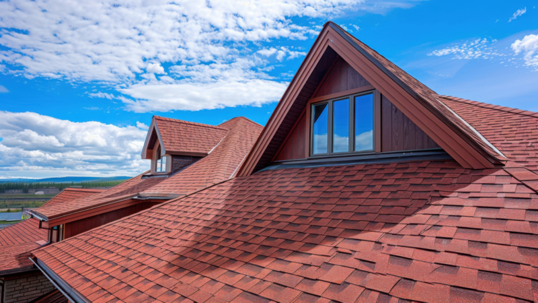Constant sun exposure can quietly destroy your roof. From UV radiation to intense heat, your roof takes a daily beating that can lead to cracking, fading, and even early failure. Understanding how to protect a roof from direct sunlight is key to extending its life, lowering energy bills, and avoiding costly repairs.
In this expert-backed guide, you'll learn how sunlight damages your roof, what materials block UV radiation best, and what you can do right now to defend your home—naturally and affordably.
What Is Sun Roof Damage?
Sun roof damage refers to the long-term deterioration of roofing materials due to exposure to ultraviolet (UV) rays, heat, and thermal cycling. Over time, this can lead to:
- Faded and brittle shingles
- Cracked surfaces and blistering
- Warped flashing or expansion gaps
- Granule loss on asphalt roofs
- Increased attic temperatures and energy bills
According to the Cool Roof Rating Council (CRRC), UV-related degradation is a leading cause of premature roof failure in hot climates.
Why You Need to Protect Your Roof from Sunlight
UV and heat exposure can:
- Shorten your roof’s lifespan by 20–30%
- Cause higher indoor temperatures
- Increase cooling costs
- Lead to premature roof leaks
Hot zones like California, Arizona, Florida, and Nevada are especially vulnerable to sun roof damage.
How to Protect a Roof from Direct Sunlight
1. Choose UV-Resistant Roofing Materials
Start with the right materials. Some roof types naturally resist UV and heat better than others.
Roofing Material | UV Resistance | Avg. Cost (per sq. ft.) | Notes |
TPO / PVC Membrane | ★★★★★ | $5 – $9 | High solar reflectance, ideal for flats |
Metal Roofing (coated) | ★★★★★ | $5 – $12 | Long lifespan and reflective coatings |
Clay / Concrete Tile | ★★★★☆ | $10 – $18 | Heavy, heat-resistant |
Cool Roof Shingles | ★★★★☆ | $3 – $5 | ENERGY STAR rated, light-colored |
Asphalt Shingles | ★★☆☆☆ | $1.50 – $4 | Prone to UV breakdown |
Wood Shake | ★☆☆☆☆ | $6 – $9 | Highly susceptible to UV and moisture |
What is the best material for UV protection?
→ White TPO membrane or coated metal roofing offers the highest solar reflectance and longevity.
2. Apply a Reflective Roof Coating
A reflective coating (like elastomeric or silicone) adds a UV shield and reduces surface temps by up to 50°F.
Benefits:
- Blocks 60–90% of solar radiation
- Reduces thermal expansion and cracking
- Saves 10–20% on cooling costs
- Extends roof life by 5–15 years
Look for products that meet CRRC and ENERGY STAR® cool roof standards.
✅ Is It Worth Getting a Roof Coated?
Yes, getting a roof coated is absolutely worth it—especially if your current roof is still structurally sound but exposed to constant sun.
Why it's worth it:
- Lower energy bills
- Delay full roof replacement
- Add years of life to your existing system
- Affordable ($1.50–$4.00/sq. ft.) compared to replacement
It’s a cost-effective solution for homes in hot, sunny regions or commercial buildings with flat roofs.
3. Add a Radiant Barrier in the Attic
Radiant barriers reflect heat before it reaches the home interior and roofing underlayment.
- Reduce attic temps by 20–30°F
- Block up to 97% of radiant heat
- Help regulate roof surface temperature
What is the natural barrier against UV radiation?
→ Radiant barriers and shade-producing structures like pergolas and overhangs.
4. Improve Roof Ventilation
Heat buildup underneath the roof accelerates wear. Use:
- Ridge vents
- Soffit vents
- Powered attic fans
This allows hot air to escape and keeps roofing materials cooler and more stable.
5. Keep Your Roof Cool Naturally
How to keep roof cool in summer naturally:
- Use lighter-colored shingles
- Install shade trees (not too close)
- Add roof overhangs or awnings
- Use vegetative or green roofs on flat structures
Signs of Sun Roof Damage
Not sure if your roof is already sun-damaged? Watch for:
- Cracking, fading, or curling shingles
- Granule loss in gutters
- Heat spots or bubbling on flat roofs
- Hot attic despite insulation
- Early signs of roof leaks
Routine inspections can catch these signs before expensive repairs are needed.
What Materials Can Block UV Radiation?
Material/Product | Purpose |
White TPO / PVC Membrane | High reflectivity, used on flat roofs |
Reflective Roof Coatings | Add-on UV protection |
Radiant Barrier Foil | Interior attic heat blocker |
ENERGY STAR–Rated Shingles | Designed to reflect solar energy |
Polyurethane Foam | Acts as an insulator and barrier |
Q: How to protect a roof from direct sunlight?
→ Use UV-resistant materials, add roof coatings, improve ventilation, and install radiant barriers or shade systems.
Q: Can UV rays really damage my roof?
→ Absolutely. UV exposure dries out and degrades many roofing materials, leading to cracking, warping, and shortened lifespan.
Q: What is the natural barrier against UV radiation?
→ Radiant barriers, tree shading, overhangs, and reflective surfaces all help.
Final Thoughts: Keep Your Roof Protected Year-Round
Knowing how to protect your roof from direct sunlight is the key to preventing premature wear, lowering energy bills, and safeguarding your home. Whether you choose UV-blocking materials, coatings, or natural shade strategies, every step helps your roof last longer.
🌞 Ready to Protect Your Roof from the Sun?
Contact a licensed roofing contractor today to learn about reflective coatings, radiant barriers, and other solar protection upgrades. Don't wait until damage is visible—protect your roof now and save thousands later.

